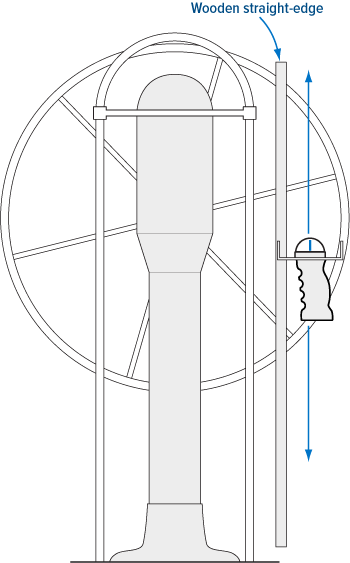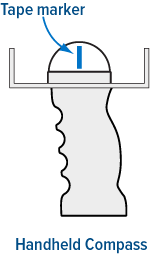Checking for Magnetic Interference
The area for mounting the control box should be free from magnetic influences, and your wheel area should be checked with a hand-held compass for magnetic fields before ordering. The helm area of most boats will be free of magnet fields, but this should be checked; use a hand-held compass to check for magnetic fields near your pedestal. Stereo speakers, dive knives, and winch handles should not be located near the control box, as well as high current cables, radar or large LCD screens.
This short video demonstrates how to check for magnetic interference at the dock:
A handheld compass that uses a needle (a simple hiking compass) is usually more accurate and easier to use than one that uses a floating card. If using a marine handheld compass with a floating card, it helps to apply a thin piece of tape as a marker on the face. Most handhelds have only 5-degree markings; a thin slice of tape as a reference can make reading card movement easier.
With your boat parallel to the dock, check the heading of the dock and boat’s heading with the magnetic compass; then step on the boat, hold the compass 3' above or away the pedestal and take a reading. The two headings should be very close. Keeping the compass oriented, approach the pedestal area and watch the needle to notice any deflection from magnetic fields. Next place a yardstick or a firm wooden straight-edge against the pedestal guardrail and rest it firmly on the deck. Hold the straight-edge steady, so it doesn’t twist. While holding the compass firmly against the straight-edge to keep the compass from rotating at all, slowly slide it up and down the straight edge and notice the amount of needle movement or deflection. The needle must not be pulled or deflected more than 5-degrees near the mounting area.

Apply a thin slice of tape as a marker on the face of the handheld compass. This will provide a reference that makes reading the compass card movement easier.

- Hold the compass edge firmly against the straight edge to keep compass oriented without movement or rotation.
- Take readings from the deck level to above the pedestal, next to each guard rail. Repeat the readings forward and aft of each guardrail.
- Compass needle deflection should not be more than 5 degrees.
You may notice some needle deflection as you pass the area just next to the ship’s compass (compensating magnets) and near the engine control levers. There is usually no needle deflection 6-10” below this area or 3" - 4" above the ship’s compass card. If the needle deflects more than 5°, a more suitable location will need to be found for the control box.
Some boats can have steel parts that have become magnetized over the years. Magnetism can come from steel in engine control cables and pins, steering cable fittings, 18-8 stainless bolts or dodger fittings, homemade guardrails, and fasteners used for pedestal tables. Welded joints or parts may also be magnetic. On a few boats, the boat’s engine is located too close and just under the pedestal which may cause a problem. Steel boats should do a careful magnetic survey, and have a mounting location at least 6 ft from the nearest steel plates.
If a suitable location is not available for the control box, use of the CPT is not recommended.
Notice for Steel Vessels
We do not usually recommend the autopilot for steel boats. The problem is that the steel interferes with the internal autopilot compass and will prevent the pilot from steering well.
The compass sensor is located inside the autopilot control box which needs to be mounted near the helm for easy access to the controls but also away from any steel or magnetism. On a steel boat, this means mounting the control box at least 6 feet away from the hull or steel structures. We do not currently have a way for the compass to be removed and mounted remotely. The control box can easily clamp to a guard rail or bimini pipe but that may not be far enough from steel to get a clean reading of the earth’s magnetic field. The control box could be mounted to a wooden pilothouse ceiling or similar and that may work. We do occasionally sell the autopilot to customers for installation on a steel boat but it is at their own risk and we cannot guarantee adequate performance of the autopilot in these situations.
Go to the top of this page